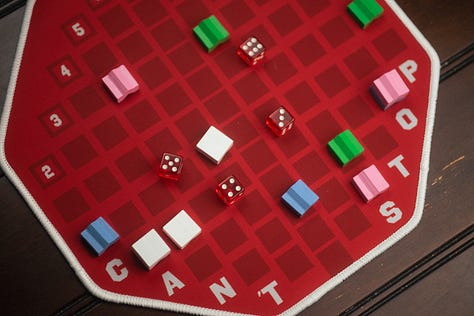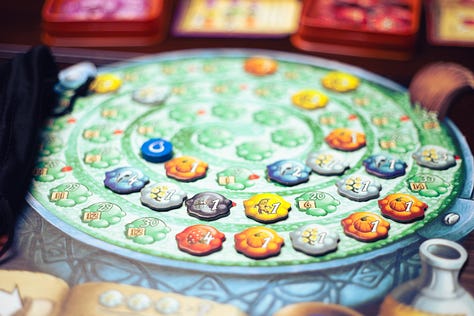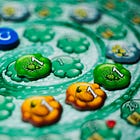Risk as an essential feature in games
We start to try to answer an age-old question: What makes a game?
There are few certainties about what makes a game a game. Finding the definition of a game — not a dictionary definition, but something genuinely useful in games criticism — has proven controversial. It is perhaps best illustrated by the discussions around The Mind (Warsch, 2018), wherein commenters discussed the merits of gamehood and the game. “Not an activity, but a game,” was a common refrain at the time, often in objection to praise the silent cooperative game received.
That is, of course, not the only time that discussion has reared its ugly head. Too often, the dictionary definition is cited, but we learn very little from a dictionary definition. From the Stanford Encylopedia of Philosophy: “Dictionaries aim to provide definitions that contain sufficient information to impart an understanding of the term.” Definitions (Stanford Encyclopedia of Philosophy) But we’re looking here for more than just understanding of a term; we want to understand the essence of a game.
I won’t be positing an essential definition this week, but through the course of the year, I’d like to establish a clearer understanding of that definition. It is not the sort of definition we can just land on in one week, so you can expect this discussion to continue.
To come at least somewhat closer to that goal, let’s establish a common trait among many games: risk.
That’s risk with a lowercase ‘r’, if it wasn’t already clear. Some will call it ‘uncertainty,’ as it’s called in the excellent Uncertainty in Games (Costikyan, 2013), which focuses itself on video games. Whatever you call it, the core idea is that games involve some element of jeopardy. I’d like to focus here on some types of games-based risk that we can find in the wild.



The clearest and most obvious type of risk in games comes in push-your-luck games, epitomized by games like Yahtzee (Lowe, 1956), Can’t Stop (Sackson, 1980) and Quacks (Warsch, 2018). These are games where you’ll aim to meet some goal, and by taking further actions in a given instance, you can bring yourself closer to those goals. Consider Yahtzee: You’re attempting to form a set of values with dice rolls, and you’re limited in your options as the game progresses. This ends with players taking riskier and riskier rolls, often unsuccessfully. In Can’t Stop, you’re attempting to climb a mountain with your dice rolls, but you can only commit to moving up in three columns each round. If you can’t move, you fail. And to demonstrate that it’s not only about dice, we have Quacks (formerly The Quacks of Quedlinburg), which combines bag-building with a clear push-your-luck element as you try to avoid pulling many cherry bombs out of your ingredient pouch.
If we confine games that involve risk to games where risk is on full display, we will miss out on a considerable outlay. We will miss out on games where we find thrill and excitement, where a calculated long-shot pays off. Even games without a strong element of randomization involve risk.
First, we come to games where you’re still basically explicitly pushing your luck, but you’re not facing a roll of the dice. No Thanks (Gimmler, 2004) sees players attempting to refuse as many cards as possible by placing a token on the current card, but they can’t refuse too many, or they’ll run out of those tokens. Each card taken, ranked 3–35 with nine cards removed, is worth points (which you’d like not to have.) If you have an unbroken sequence of cards, you only take points for the lowest card in the sequence. Risk comes in two distinct forms here: First, because nine cards are removed, any attempt to make a sequence of cards — especially one in which you’re trying to bridge a gap — carries with it an element of chance. Second, you’re playing against the risk of human decision. Perhaps you’re playing against someone risk averse, and you can be relatively certain that they won’t take the card you’re looking for — or perhaps they are anything but averse, and they’ll leave you footing the bill. It’s a tremendous little game, and you’ll consistently find that you’re engaging with risk every time your turn comes around.
Second, we come to games where risk is integrated into the mechanisms but which don’t use it quite so explicitly. The classic cooperative game Pandemic (Leacock, 2008) is illustrative. In Pandemic, you’re playing as a team trying to eradicate four diseases across the globe, and those diseases pop up in hotspots in cities through a deck of city cards, which is shuffled at the start of the game. When a city card is drawn, a cube is placed on the accompanying city on the map, and if any city has three cubes before placing a new one, an outbreak is triggered, and all neighboring cities receive a cube instead. If you run out of cubes or have too many outbreaks, you’ll lose the game. At somewhat randomized points throughout the game, you’ll draw an epidemic card, which shuffles all drawn cards (plus one new one from the bottom of the deck) and puts them back on top of the city deck.
We are dealing specifically here with input randomness, which game designer and ludologist Geoff Englestein in GameTek Classic 183 as “random things that happen before you take an action, then you have to make a decision based on that, but the actions that you take have a definite outcome.” In Pandemic, your actions have that definite outcome. If you attempt to remove a disease cube, it doesn’t stick around half the time — it’s just gone. Still, the game involves a great deal of risk. Given the city deck is shuffled after an epidemic card is drawn, you are constantly facing the threat of an outbreak. You might concentrate as a team in one area, but you will introduce risk: You might infect a city halfway across the map, or you might hit an epidemic that throws everything into disarray. Risk is baked into every element of Pandemic, but nobody would call it a push-your-luck game.
Third, we’ll move to games where risk comes in the form of non-deterministic action, or output randomness. Englestein defines output randomness: “You take an action, and the outcome of that event is random.” Risk can come in the form of output randomness without being inherently less fulfilling, though we’ll find it’s often used as a replacement for actual risk. Consider the ubiquitous Snakes and Ladders, wherein you roll dice and move on a board, but depending on where you land, you may either move up or down on the board. You have no control over your actions aside from rolling dice, so unless you’re particularly good at rolling dice, you’ll gain no advantage through your actions. Risk is a non-factor in games like this because player agency itself is a non-factor. Some might argue these are not games — I am not so sure, but if our only consideration is risk, then it’s certainly a good argument. Again, in the coming weeks, we’ll talk about that.
Having output randomness as a feature is itself not damning. Risk (Lamorisse, 1957) — the classic board game and not the abstract concept we’re discussing here — is not a horrific game because you roll dice to determine the fate of your warfaring actions. It is perhaps flawed, but it’s indisputably a game. The risk you’re taking is in attacking, because you know there’s a chance your dice rolls won’t work in your favor. Small World (Keyaerts, 2009), which feels like a sequel to and improvement upon Risk, sometimes features dice rolling during attacks, and it’s refined to such a point that it doesn’t suffer from the small element of output randomness: Instead of determining outcome on its own, it can supplement it if you’re not strong enough. The area of risk has shifted, despite the games being somewhat related here. Now, the risk you take is in going to a battle underpowered, but you know that the dice can only improve your position, or in the case of the blank die face, leave it as-is.
Finally, games where the risk is in interacting with other players alone, even when the interactions are somewhat indirect. Agricola (Rosenberg, 2007) is an exemplar: In this worker placement game, some spaces accrue value over time. Most spaces are also restricted to just a single player occupying them, thus gaining the benefit of the space. Despite having neither input randomness nor output randomness, your ability to feed your in-game family depends on you being able to get food, and if somebody takes the food you were planning on using, they may just have to go hungry. Your actions may not produce immediate uncertainty, but they absolute invite an element of risk.
We can look deeper at numerous card games here as embodying both player-engagement risk and input-randomness risk. Games like Uno (Robbins, 1971) and Hearts (1850) involve risk in your opponents’ actions as well as the cards you draw. The risk is straightforward here: In Uno, you will be faced with opposition to your actions. Shedding your hand won’t come easily, and you’re always engaging with risk. In Hearts, you may end up taking the Queen of Spades unexpectedly, resulting in far more points than you had planned. Haggis (Ross, 2010), likely my favorite climbing game, features it heavily, and it’s what gives the game its clear stakes. In Haggis, you can play a bomb — in order of strength, 3/5/7/9 in four different suits, stepped combinations of J/Q/K, and 3/5/7/9 in one suit — that results in you winning the trick unless somebody plays a stronger bomb. When you play a bomb, you are taking on the risk that your opponent has something stronger, whether they play it immediately in response or not. Trick-taking and climbing games have risk baked directly in to the foundation of the genre.
When we come back to this general theme of what makes something a game, we’ll focus on another topic: fun. From the outset, I think we can establish that games don’t need to be fun, and we can look at a host of examples for evidence.
Thank you, as always, for joining me at Don’t Eat the Meeples! Apologies for getting this one out a little later than usual, but I wanted to make sure I got to everything I was hoping to — there weren’t just games I could trim off and talk about in the future. I hope this somewhat more abstract topic produced a reasonably worthwhile read.
I’m not quite sure what I’ll be writing about next week, but I’ll be traveling, so really — who knows what’ll come of that. We’ll talk then!






